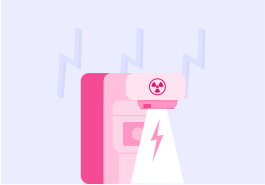YOU ARE LEARNING:
PET Scanners and Tracers

PET Scanners and Tracers
By tracking the radiation emitted from medical tracers, doctors can check the functionality of internal organs.
Radioactive isotopes can be used to make medical tracers.
To trace means to find or discover something by investigation
So medical tracers are used to explore internal organs to see how well they function or to visualise bone structures and spot damage.
Doctors can place certain radioactive isotopes inside a persons body, either by injecting them or getting the person to swallow them
They can then track the movement of the isotopes around the person’s body, by tracking the radiation that they emit.
This can be extremely useful to check whether an organ is functioning normally or to see if there is cancer anywhere.
Which type of radiation can most easily pass through the body?

The radiation from a medical tracer has to be able to pass through the body. Otherwise we can't detect it. This is why gamma radiation is normally used. It's weakly ionising, but it has very high penetrating power, so it passes through the body easily.
An example
Medical tracers are used to diagnose a patient who might have a dysfunctional thyroid gland
The thyroid gland is a gland in you neck that absorbs iodine and turns it into hormones.
Doctors give some radioactive iodine-123 to the patient to drink
They then see if it is absorbed properly by the thyroid.
What type of radiation do you think iodine-123 emits?

When the radioactive iodine decays, it emits gamma radiation
The radiation passes through the body and is detected by a scanner. If the scan shows that the thyroid has absorbed too much or too little iodine, then the doctor can use this to diagnose the patient’s condition.
What do you think the radioactive iodine decays into?

We want medical tracers to decay into something stable
Otherwise, the patient could be left with radioactive substances in their body after the testing. For example, iodine-123 decays into tellurium-123 which is very stable and harmless.
Using medical tracers for thyroid testing usually takes up to 24 hours. What do you think the half-life of the tracer should ideally be?

When designing medical tracers, we need the radioactive isotopes to stay radioactive for exactly the right amount of time for the doctors to take their measurements.
But, once the tests have been done, we want to make sure the isotopes are no longer radioactive. This can all be controlled by making use of the isotope's half-life.
Recap on medical tracers, for example iodine-123 for thyroid gland testing.
The best kind of radiation is gamma radiation...
because it passes easily through the body and is not very ionising. However, sometimes beta radiation might also be used.
We definitely don't use alpha radiation...
because that is highly ionising so it could cause great damage to bodily tissues inside the body.
We must make sure that the tracer does not decay into another radioactive isotope...
because we don't want any radioactive isotopes left in the body after doctors have measured what they need.
So we should use tracers that have quite a short half-life...
because they don't stay in the body for a long time.
Radiation can be very useful, but it can also be harmful, so the risks must be weighed up against the benefits
For example medical tracers can help diagnose diseases, so it's generally worth the risk if it's likely that the patient does in fact have the disease.
PET scanners
Positron Emission Tomography (PET) scanners are a specific type of medical tracer. What kind of radiation is a positron?

When a positron crashes into an electron, they destroy each other. They get converted into two gamma rays that are emitted in opposite directions. So what do you think the Geiger-counters in a PET scan detect?

Like other medical tracers, PET scans are used to detect gamma rays that are emitted from the tracers
Now, the tracers that are used for PET scanners are individually manufactured by scientists in the hospital.
To make a tracer, a scientist creates some radioactive atoms by smashing high-speed particles into ordinary atoms making them unstable and radioactive. Do you think these will have a short or a long half-life?

The scientist uses these unstable isotopes to quickly create a biological molecule that has some of the radioactive atoms in it
This can be anything from a sugar molecule to a protein, depending on what is most suitable for the patient. It then gets injected into the patient.
Why do you think it is important that these tracers are created near the patient?

PET scans are unique because the medical tracers used are individually made for each patient.
The scans produce 3D images of the internal workings of the body, and are used to detect cancer, test heart function, and can even track Alzheimer's.
Summary
Radioactive isotopes can be used to make medical tracers
Doctors can follow the tracers around the body, so they can use them to check for example the function of internal organs or to check for bone damage.
Medical tracers use gamma radiation
This is because gamma radiation passes through the body easily.
We want medical tracers to decay into something stable
Otherwise, the patient could be left with radioactive substances in their body after the testing.
Also, we should use tracers that have quite a short half-life
Tracers with short half-lives don't stay in the body for a long time.
Tracers for PET scans are special
The medical tracers used are individually made for each patient in the hospital. They decay quickly so they have to be made close to where the patient is.
